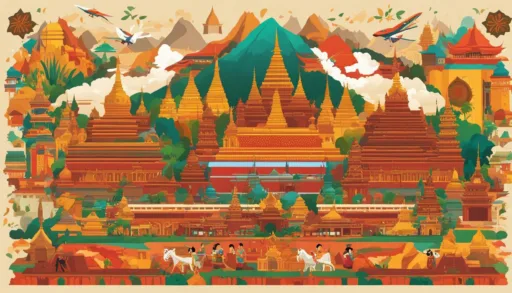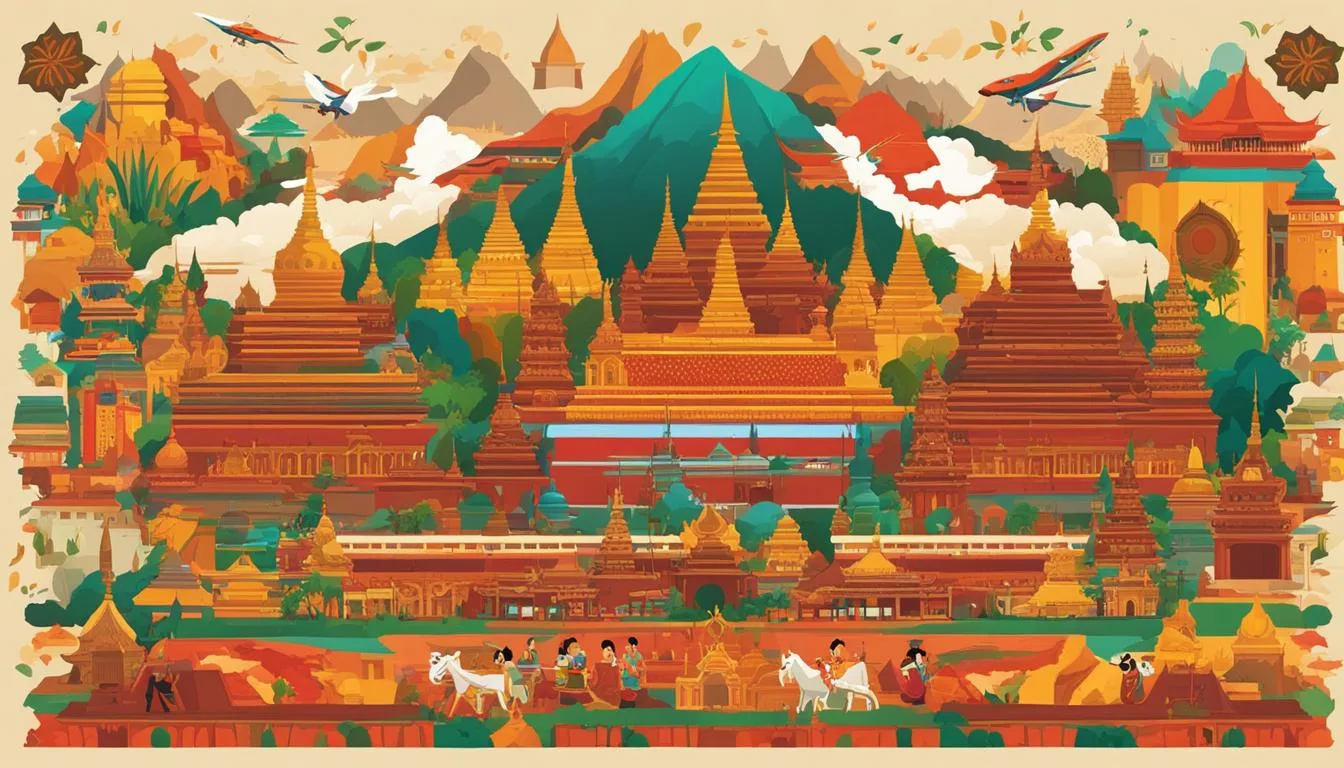Here’s a fact that might catch you by surprise: Myanmar, a Southeast Asian cultural mosaic, is home to a linguistic ensemble of approximately one hundred languages. This staggering number celebrates the breadth of linguistic diversity Myanmar offers, but that’s just the surface of the country’s rich verbal tapestry. The Myanmar language, predominantly Burmese, bridges the daily communication of about two-thirds of the populace, highlighting its role as a cornerstone in the fabric of the nation’s identity.
Beyond the ubiquity of the languages spoken in Myanmar, this linguistic diversity extends across six distinct language families, each contributing its unique phonetic flourishes to this polyphonic nation. However, in this rich tapestry, a paradox emerges; while the country revels in this linguistic wealth, the minority languages are often overshadowed, actively edged out in favor of the dominant Burmese tongue. Delve into the labyrinth of Myanmar’s languages, where history, culture, and politics intertwine to shape a nation’s voice.
Key Takeaways
- Myanmar boasts nearly 100 different languages, a testament to its immense linguistic diversity.
- The Burmese language serves as the backbone of national communication, used by the majority of the population.
- Myanmar’s language landscape spans six language families, underscoring the multicultural fabric of the nation.
- The proliferation of ethnic minority languages adds rich layers to the cultural and linguistic diversity of Myanmar.
- Despite the vast array of tongues, there is a palpable tension between preserving linguistic heritage and the prevailing dominance of Burmese.
The Significance of the Burmese Language in Myanmar
The Burmese language, as the official language of Myanmar, is an integral part of the country’s cultural and political landscape. Its widespread use among the Bamar population and assorted ethnic groups showcases Myanmar’s commitment to its linguistic heritage.
Burmese: The Official Language
Indicative of the rich tapestry of main languages Myanmar offers, the Burmese language, hailing from the Sino-Tibetan language family, is not only the official but also the most widely spoken language in the nation. With its unique writing system and status as a first language for over 33 million people, the Burmese language is a central pillar in the Myanmar’s cultural identity. Its prevalence extends beyond the majority Bamar community, impacting various ethnic groups, including the Mon.
Dialects of the Burmese Language
The Burmese language’s vibrancy is further exemplified by its regional dialects Myanmar has harbored within its borders. These dialects, which differ mainly in pronunciation, vocabulary, and usage across geographic regions, add a dynamic character to the Burmese language and reflect the nation’s diverse collective experience.
Role of Burmese in Education and Media
Burmese importance illuminates in higher education and media — domains that deeply influence societal norms and knowledge dissemination. As the Burmese language dominates as the primary medium for instruction and communication, it also functions as a bridge uniting Myanmar’s multiple ethnicities under a shared linguistic canopy, supporting both tradition and modernity in Myanmarese life.
| Burmese Language Influence | Aspect | Details |
|---|---|---|
| Official Status | Legal and Administrative Use | Used in government, legal systems, and national broadcasts |
| Educational Medium | Schools and Universities | Primary language of instruction; English is secondary |
| Cultural Impact | Literature and Media | Extensive use in literary works, newspapers, and television |
| Linguistic Reach | Population and Ethnicities | First language for 33 million; second language for 10 million |
Burmese isn’t just a mode of communication; it’s a symbol of identity that plays a profound role in the fabric of Myanmarese society. The continued prominence of the Burmese language in education and media underscores its value to the people of Myanmar, marshaling unity in its diverse and dynamic cultural landscape.
Linguistic diversity Myanmar: Ethnic Languages and Their Influence
The cultural landscape of Myanmar is a testament to the country’s wide linguistic diversity, which encompasses an array of vibrant ethnic languages. Influential languages from the Sino-Tibetan, Tai, and Mon-Khmer families are integral to the nation’s communication and cultural traditions. Among the myriad of tongues spoken, certain languages such as Shan, Karen, Kachin, Chin, and Mon stand out for their contribution to racial and cultural dynamics, though the historical discouragement of minority languages presents an ongoing challenge to their vitality.
Myanmar’s linguistic mosaic is not just a feature of its social fabric but also a mirror reflecting the nation’s complex history of migrations and interactions among various ethnic groups. Here’s a highlight of several notable ethnic languages of Myanmar and their unique impact:
- Shan: Predominant in the Shan State, this Tai language contributes significantly to regional identity.
- Karen: Spoken by the Karen people, it reflects the diversity within the Tibeto-Burman family and is a vehicle for folklore and communal narratives.
- Kachin: With several dialects, the Kachin language encompasses an oral and increasingly written tradition among the Kachin people.
- Chin: A linguistic group with multiple dialects, emphasizing the diversity within the Chin State.
- Mon: An Austroasiatic language that is one of the oldest recorded languages in Myanmar, indicating profound historical roots.
The use of the Myanmar script by many of these ethnic languages not only highlights their adaptability but also their resilience in maintaining linguistic relevance despite socio-political pressures. The present scenario, informed by greater awareness and appreciation for the rich tapestry of ethnic languages in Myanmar, signals a growing understanding of the critical role they play in preserving cultural legacy and fostering linguistic diversity in Myanmar.
languages spoken Myanmar: The Kaleidoscope of Myanmar’s Linguistic Landscape
Myanmar’s linguistic landscape is as diverse and colorful as its rich cultural tapestry. Home to significant ethnic groups, each with its own linguistic roots, Myanmar offers a riveting exploration of language families, from the dominant Sino-Tibetan to the lesser-known Austroasiatic variants. This linguistic variety shows the nation’s long history of migrations, trade, and cultural exchanges, reflecting an intricate blend of civilizations across time.
Sino-Tibetan Languages of Myanmar
The Sino-Tibetan languages are at the heart of Myanmar’s phonological and cultural matrix. Encompassing a plethora of dialects and languages like Burmese, spoken by the majority, as well as diverse tongues articulated by the Chin and Kachin, this family illustrates the complex ethnic jigsaw puzzle that is Myanmar. These languages have evolved over centuries, branching out into distinctive linguistic streams that are vital to understanding the region’s history and identity.
Austroasiatic Languages in Myanmar’s Cultural Mosaic
Amid the ethnolinguistic profiles dominating Myanmar, the Austroasiatic languages emerge, narrating tales of historic settlements and conquests. Languages such as Mon, associated with one of the earliest civilizations in the region, and Palaung, continue to be the cultural insignia for their respective ethnic groups. Even as they may not enjoy the same prevalence across the national spectrum as Burmese, their continuation is an emblem of the nation’s heritage.
Tai-Kadai and Austronesian Contributions to Myanmar’s Languages
The Tai-Kadai languages bring to the foreground groups like the Shan, who inhabit the fertile plains of the Shan State, and the Khün community, immersing linguists and cultural enthusiasts alike in their rich lingual expressions. Equally fascinating are Myanmar’s Austronesian speakers, such as the Moken, who are traditionally sea nomads, their language sprinkling the coastal areas with its unique phonetic character.
Indo-Aryan and Dravidian Linguistic Presence
The demographic interplay in Myanmar allows for languages beyond its immediate geographic lineage, with Indo-Aryan and Dravidian languages played out in the social symphony. Bengali and Tamil, each with sizable speaking populations, exhibit the porous nature of Myanmar’s linguistic frontiers and the socio-economic narratives that led to their spread and survival in this Southeast Asian nation.
The Presence of English and Other Foreign Languages in Myanmar
The linguistic tapestry of Myanmar is rich and diverse, textured by the threads of multiple languages, including English and other foreign tongues. The deep historic roots of English in Myanmar have evolved over time, giving way to a contemporary landscape where English and a variety of other languages are still significant in various facets of society.
History of English Language Use
From the late 19th to the mid-20th century, Myanmar, then Burma, was under British colonial rule, marking an era where English was established as the official language. This period ingrained English into the administrative, legal, and educational systems of the country. Even after independence, the echoes of English lingered and were symbolically significant in bridging Myanmar with the global community.
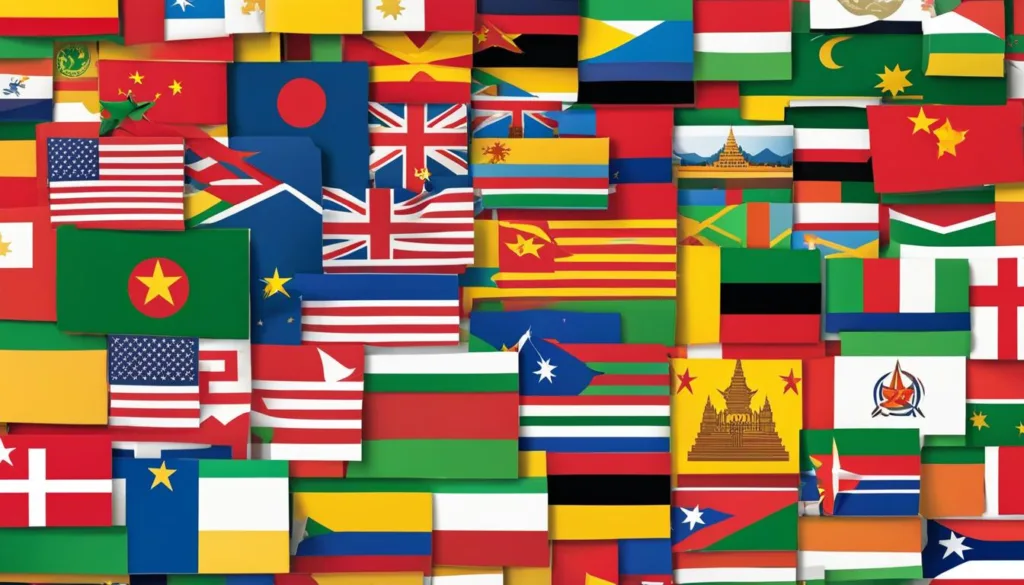
Contemporary Use of English and Other Foreign Languages
In the modern-day, English Myanmar relations reflect the nuanced dance between tradition and global engagement. English is no longer the official language but remains compulsory in the national education curriculum, strongly influencing professional domains, especially in the fields of tourism, business, and international relations. Beyond English, the influence of other foreign languages Myanmar hosts, such as Mandarin Chinese and Indian languages, signifies the intricate interplay of culture and commerce. The prevalence of these languages within the business sector notably demonstrates Myanmar’s strategic economic relationships and its role as a cross-cultural hub in Southeast Asia.
Mandarin Chinese, for instance, is prevalent due to Myanmar’s proximity to and business with China, while South Asian languages reflect centuries-old migration and trade patterns. Consequently, these languages are not just markers of communication but are also emblematic of Myanmar’s historical and ongoing socio-economic linkages with neighboring regions.
Understanding the role of English Myanmar dynamics and other foreign languages Myanmar encompasses is key to appreciating the country’s identity—a syncretic blend where linguistic heritage meets the demands of a globalized world.
Major Languages and Dialects Across Myanmar’s Regions
Delving into the heart of Southeast Asia, we navigate through Myanmar, a nation celebrated for its cultural diversity shaped by the numerous dialects and regional languages that are spoken. Each region weaves a unique linguistic tapestry, epitomizing the country’s rich heritage. The Burmese language stands as the lingua franca in the plains, while distinct dialects of Myanmar are prevalent along the coasts and in the highland communities.
In the verdant plains, the Burmese language is joined by the Shan and Rakhine languages. A trip down to the Rakhine and Tenasserim coasts reveals a specialized form of Burmese that harbors its own idiosyncrasies, while the rugged terrains of the highlands are home to a bouquet of dialects: the Kachin, Chin, and Shan languages echo through the hills, attesting to the kaleidoscopic ethnic diversity.
Creating a bridge between past and present, the evolution of written forms for languages such as Karen, Kachin, and Chin stands as a testament to the dynamic nature of linguistic development in Myanmar. The following table provides an insight into the major regional languages and dialects you may encounter on a journey through this enchanting country:
| Region | Major Language | Dialects Spoken |
|---|---|---|
| Plains | Burmese | Standard Burmese, Rakhine, Shan |
| Coasts | Burmese | Rakhine Coastal Dialect |
| Hill Regions | Multiple Languages | Kachin, Chin, Shan Highland Dialects |
While dialects of Myanmar differ from region to region, a collective respect for linguistic tradition unites the country. Though across the global stage the linguistic spectrum of this nation may go understated, within its borders, the regional languages of Myanmar are the very fabric of its identity. They are held close, celebrated, and endeavored to be preserved for generations to come, as intrinsic to the Myanmar experience as the land itself.
Myanmar’s Efforts in Language Preservation and Revitalization
In a commendable stride towards safeguarding its rich cultural tapestry, Myanmar has embarked on a series of initiatives designed to preserve its linguistic heterogeneity. Amid globalization and the encroaching prevalence of widely spoken languages, the country is reconciling modernizing education systems with the need to maintain its unique linguistic heritage.
Challenges for Minority Languages
The multiplicity of languages within Myanmar belies the intricate challenge of cultural preservation faced by minority groups. These languages, inseparable from the identities of various ethnic communities, confront the realities of diminishing fluence as societal and technological shifts enable the dominance of more ubiquitous tongues. With a desire to maintain relevance on the global stage, linguistic minority communities are in a relentless battle to keep their languages vibrant and viable.
Education Policies and Language Preservation Programs
Education policies in Myanmar have become the pivot through which language preservation efforts are articulated. Prescriptive measures have seen the nurturing of linguistic diversity through the incorporation of ethnic languages in localized curriculum frameworks. Additionally, language preservation programs have catalyzed the creation and formalization of writing systems, ensuring a tangible continuity of these languages into the future.
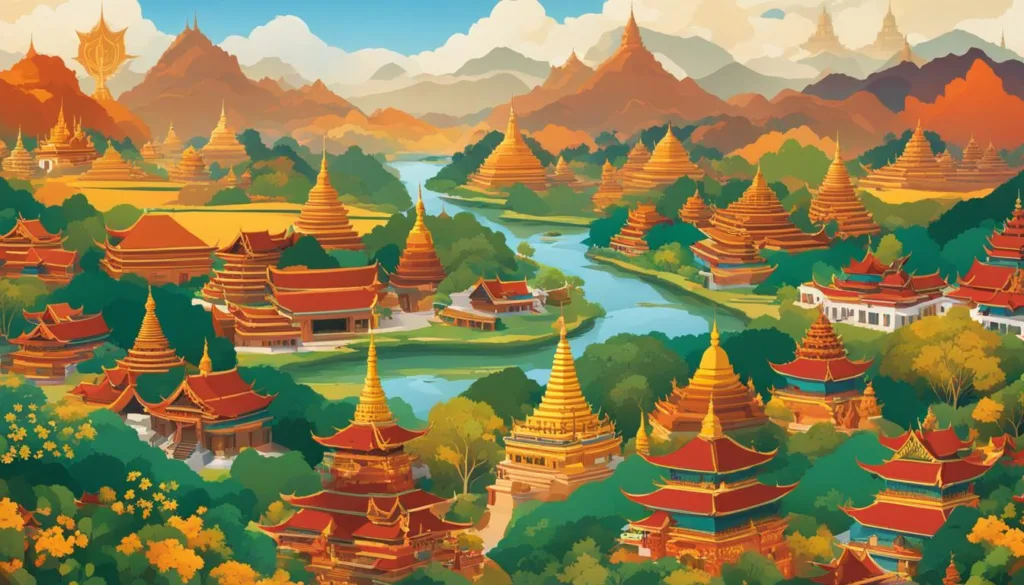
“Myanmar’s linguistic diversity is not merely a national heritage; it embodies the spirit and wisdom of all its ethnicities. The task of preserving these tongues is akin to hoisting the sails of a vast fleet—each language is a vessel carrying its own legacy across the currents of time.”
| Language | Region | Status | Preservation Initiatives |
|---|---|---|---|
| Kachin | Kachin State | Vulnerable | Development of Kachin language textbooks |
| Chin | Chin State | Endangered | Formalization of the Chin language curriculum |
| Karen | Kayin State | Threatened | Support for Karen language radio broadcasts |
| Mon | Mon State | Vulnerable | Cultural festivals celebrating Mon language and literature |
| Shan | Shan State | Widely spoken | Inclusion in higher education syllabus |
With a robust commitment to sustaining the future of its languages, Myanmar stands as a vanguard, underscoring the importance of language preservation Myanmar within the broader markers of cultural integrity and identity. Education policies Myanmar have been pivotal in these ventures, signifying the nation’s resolution to be both a guardian of tradition and a harbor of educational progress.
Literature and Script: Burmese Writing System and Other Alphabets
The Burmese writing system is a fascinating element of Myanmar’s cultural landscape, entrenched in the nation’s literary canon. It serves as the cornerstone of communication and cultural identity among the Burmese-speaking population. With its origins tracing back to the Brahmi script of ancient India, the Burmese script has evolved over centuries, encapsulating the essence of Myanmar’s literary heritage.
Aside from the widespread use of the Burmese script among the Bamar populace, Myanmar is also home to an assortment of Myanmar alphabets employed by various ethnic groups. These scripts, while sharing similarities with the Burmese system, have been adapted to suit the phonologies of the respective languages such as Karen, Kachin, and Shan.
- The Shan script, while resembling Burmese, includes additional characters to represent sounds unique to the Shan language.
- The Karen people use a script derived from the Burmese system, which has been modified to incorporate tones that are vital to Karen languages.
- Kachin, another language group, utilizes a script that has been uniquely evolved from the Burmese writing system to express the complex tones and sounds found in the Kachin language.
These scripts are not merely tools for communication; they are a means to preserve a rich tapestry of oral and literary traditions. They represent a form of resistance to cultural assimilation, upholding linguistic diversity as the country moves towards a more inclusive recognition of its multi-ethnic makeup.
Each script is a safeguard for the many voices of Myanmar, ensuring that the stories, poems, and histories of each community continue in written form for generations to come.
The table below illustrates a comparison of selected characteristics belonging to the Burmese writing system and other Myanmar alphabets.
| Characteristics | Burmese Script | Shan Script | Karen Script | Kachin Script |
|---|---|---|---|---|
| Adapted from | Brahmi Script | Burmese Script | Burmese Script | Burmese Script |
| Language Family | Sino-Tibetan | Tai-Kadai | Sino-Tibetan | Sino-Tibetan |
| Unique Sounds | Consonants, vowels, tones | Distinctive tones, vowels | Four-tone system | Complex tonal system |
| Literary Tradition | Extensive | Rising recognition | Developing | Emerging |
The distinct scripts offer not only a window into the soul of various Myanmar cultures but also provide a platform for literary expression and communication. This intrinsic relationship between language and script highlights the incredible linguistic wealth found within the borders of Myanmar, which is not only a treasure to linguists and historians but to all who appreciate the rich diversity of human expression.
Understanding Myanmar’s Multilingual Society: Social and Cultural Aspects
The tapestry of Myanmar’s society is rich and complex, shaped by a history of diverse linguistic groups interacting and living alongside one another. In this multilingual society of Myanmar, the social dynamics of language use play a pivotal role in the daily lives of its people, reflecting the intertwined nature of language, culture, and identity. The mingling of ethnic groups and their languages has fostered a unique social environment where communication and cultural expressions are deeply informed by a multilingual reality.
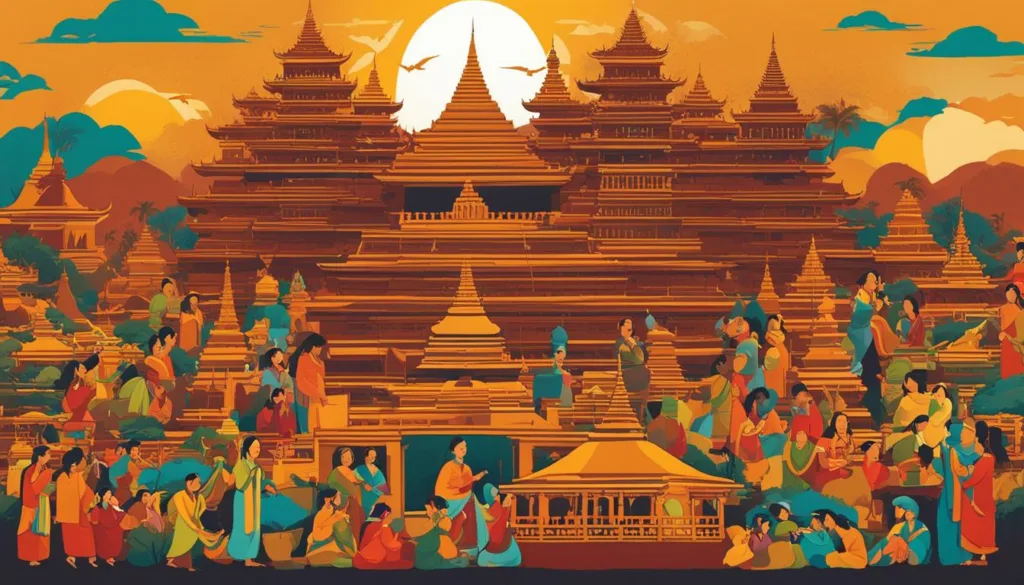
Social Dynamics of Language Use in Myanmar
Myanmar’s sociolinguistic landscape is fascinating, not only due to the sheer number of languages but also due to the subtle nuances of social dynamics that these languages engender. The use of language within different communities can signal social status, educational background, and even political allegiance. The positioning of the Burmese language as the lingua franca has both facilitated interethnic communication and presented challenges in maintaining the linguistic diversity that is so characteristic of the country.
Language in Myanmar’s Religious and Ethnic Identity
Religious and ethnic identities are salient aspects of the multilingual society in Myanmar. Buddhism, the predominant religion of the country, acts as a unifying force and influences linguistic practices to a great degree. Languages in Myanmar, such as Shan, Mon, and Kachin, are not merely tools for communication; they are emblematic of the country’s mosaic of ethnic communities. These languages are intimately connected with religious ceremonies, traditional customs, and the heritage of each ethnic group, adding layers of meaning to the rich social dynamics of Myanmar.
Socio-Political Factors Influencing Language in Myanmar
The confluence of socio-political dynamics has played a pivotal role in sculpting the linguistic tapestry of Myanmar throughout its history. As a nation with rich ethnic diversity, language policies have not just mediated communication but also facilitated the political agenda and cultural preservation.
Policy and Governance Impacting Language
Historically, the official stance on language usage and instruction was influenced by the ruling government’s objectives. In recent years, there has been a discernible shift towards acknowledging ethnic languages in educational and bureaucratic domains. Yet, the enduring preference for Burmese underscores the complex interplay between governance and linguistic hegemony.
Language in the Context of Myanmar’s Historical Milestones
The legacies of colonialism and the unification under various empires have indelibly marked the contours of language evolution in Myanmar. With each epochal turn, the socio-political matrix redefined language status and utility. Below is an insightful glance into the pivotal milestones that have impacted the language policy in Myanmar.
| Historical Milestone | Impact on Language Policy |
|---|---|
| British Colonial Rule | Introduction of English; subsequent education policies aimed at Anglicization. |
| Myanmar’s Independence (1948) | Shift towards Burmese nationalism, promotion of Burmese as the national language. |
| Military Rule and Ethnic Conflicts | Suppression of ethnic languages and centralization of Burmese in state apparatus. |
| Democratic Transitions | Gradual recognition of ethnic languages in the framework of education and local governance. |
In aligning with these historical influences, the government’s contemporary language policy in Myanmar is curated to foster unity while treading a fine line of cultural acknowledgment and political feasibility.
Conclusion
Myanmar’s wealth of languages is as varied and colorful as the nation’s own tapestry of cultural identities. The dominant Burmese language serves as the keystone in the arch of linguistic diversity, creating a bridge between Myanmar’s past and its present. The sounds of countless ethnic languages reverberate throughout the highlands and plains, each adding a unique thread to the country’s intricate cultural fabric. Amidst globalizing currents and a shifting socio-political climate, the intersections between these languages weave a tale that speaks to both tradition and transition.
Summary of Languages Spoken in Myanmar
The narrative of Myanmar is told in over a hundred languages, a testimony to its multidimensional linguistic landscape. From Burmese, with its expansive reach, to the vibrant array of ethnic languages like Shan, Karen, and Kachin, Myanmar’s voices are as diverse as they are dynamic. The presence of English and other foreign tongues marks the historical interplay of cultures and the pragmatics of modern commerce and education, illustrating a nation at the confluence of heritage and progress.
Future Outlook on Myanmar’s Linguistic Diversity
What does the future hold for linguistic diversity in Myanmar? The answer lies in the balance between preserving the resonance of indigenous voices and embracing the necessities that come with global participation. As Myanmar strides into the future, it carries with it the legacy of its languages, ensuring that each word spoken—whether in Burmese, an ethnic dialect, or a foreign language—continues to enrich the collective human experience. The commitment to nurturing **future linguistic diversity in Myanmar** is pivotal, not merely for the sake of cultural preservation, but also for fostering a society that is inclusive, enlightened, and forever conversant with the richness of its history.
FAQ
What languages are spoken in Myanmar?
Myanmar is a linguistically diverse country with around one hundred languages. The official language is Burmese, and many ethnic minority languages are also spoken across its regions within six language families: Sino-Tibetan, Austro-Asiatic, Tai–Kadai, Indo-European, Austronesian, and Hmong–Mien.
What is the significance of the Burmese language in Myanmar?
Burmese is the official language of Myanmar, serving as the lingua franca and heavily influencing national identity. It is spoken by the Bamar people and a multitude of sub-ethnic groups including several ethnic minorities. Burmese is also the primary language of instruction in education and the dominant language in media.
Are there different dialects of the Burmese language?
Yes, there are several dialects of Burmese, which vary mainly by region. Notable variants include the standard Yangon dialect, the Ayeyarwady dialect, and rural dialects. There is also a distinct form of Burmese spoken in the Rakhine and Tenasserim coastal areas.
What is the role of Burmese in education and media?
Burmese is the primary language of instruction in Myanmar’s education system, with English as a secondary language. In the media, Burmese is dominant across television, radio, newspapers, and online platforms, solidifying its presence in daily communication and national discourse.
How does linguistic diversity in Myanmar reflect its ethnic groups?
Myanmar’s linguistic diversity mirrors its ethnic composition. Languages from the Sino-Tibetan, Tai, and Mon-Khmer families, among others, are spoken by various ethnic groups throughout the country. This diversity is an integral part of Myanmar’s cultural heritage.
What is the status of English and other foreign languages in Myanmar?
English has a historical presence in Myanmar and is the primary foreign language taught in schools. Other foreign languages, such as Mandarin and various Indian languages, are spoken within certain communities and hold a presence, particularly in commerce and trade.
Which languages are spoken in the hill and plain regions of Myanmar?
In the plains, major languages include Burmese, Shan, and Rakhine. The hill regions are home to languages like Kachin, Chin, and Shan. These languages reflect the ethnic diversity of those geographical areas.
What efforts are being made to preserve and revitalize languages in Myanmar?
There’s a growing recognition of the need to preserve linguistic diversity. Efforts include the introduction of language preservation programs, development of written forms for languages that previously lacked them, and more inclusive education policies that encourage the learning of ethnic languages and English.
How does the Burmese writing system impact Myanmar’s literature and scripts?
The Burmese writing system is central to Myanmar’s literary tradition. It’s used for writing the Burmese language and has been adapted for a number of ethnic languages as well. This script not only bolsters the cultural identity of the Bamar people but also supports the literary traditions of various ethnic groups.
Can you explain the relationship between language, social dynamics, and cultural practices in Myanmar?
Language in Myanmar is deeply connected to social and cultural life, reflecting and shaping the complex interrelations among the country’s various ethnic and religious groups. It plays a crucial role in interpersonal relationships, community cohesion, and the transmission of cultural practices and beliefs.
What are the socio-political factors influencing language use in Myanmar?
Language use in Myanmar has been influenced by government policy, historical events, and the country’s ethnic diversity. The evolution of language status and the emphasis on certain languages over others have been shaped by political governance, with Burmese widely promoted as the national language at the expense of minority languages.
